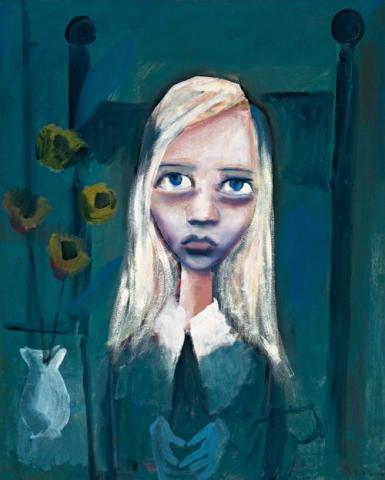PRELUDE TO ALICE , c.1955 VERSO: SEATED PORTRAIT
Charles Blackman
oil on cardboard (double-sided)
92.0 x 74.0 cm
signed lower right: BLACKMAN
Hal Hattam, Melbourne
Thence by descent, private collection, Melbourne
Savill Galleries, Sydney
Private collection, Sydney
...The pictures invoked in me by Alice's story are highly personal. They are all about her [Barbara], but they are also about entering into the surreal world with the whole concept of surrealism which I've always loved as a painter...'1
Although he had previously heard of Alice in Wonderland, Charles Blackman first encountered Lewis Carroll's celebrated tale in 1956 as a recording from the talking book library, borrowed by his wife Barbara who had been legally blind for over five years. Almost immediately, the artist was struck by the remarkable parallels between the fabulous Alice and the familiar Barbara - the disoriented person; the one who negotiates with a calm that is sometimes desolate, sometimes trusting and entirely without surprise; the topsy-turvy world of objects, dimensions, happenings. Moreover, just as 'Alice was moving enquiringly, questioningly, trustfully, bemusedly, changefully, into a new and strange world, trying with good sense and honesty to get her bearings in it, however often she seemed to change body shape...'2, so too Barbara at the time was experiencing an increasing sense of spatial disorientation caused by her first pregnancy which was to coincide with the genesis of the series and inform the nine months of its production.
As envisaged by its title, Prelude to Alice c1955 is a precursor to this widely acclaimed exploration into 'wonderland'- the world of imagination, of experience, of feeling, where reality is not so much seen or measured but rather, apprehended from within. With her tenderness and vulnerability, the figure is reminiscent of the controversial 'Schoolgirl series' which Blackman had recently completed, while at the same time bearing affinities with the metaphor of Barbara as Alice, illuminated by Judith Wright in her 'Introduction' to the catalogue accompanying the second 'Alice' exhibition held at the Johnstone Gallery, Brisbane in 1966,
'...We seldom see the girl's face; but when we do her eyes are full of calm. She is kind and innocent, but never ignorant; she retains her perfect common sense in all situations, but when a masquerade is carried on too long, she is quite capable of overturning it and demanding that it recognise its own foolishness. She is the perfect companion for a painter, and Blackman was wise enough to know it from the moment she appeared. Here, she is Alice; he painted her in this role ten years ago. She is lucky to be known so well by a great painter; but he is lucky too, to have found her waiting for him at the all-important crossroads in his own world, and to have recognised her for the touchstone that she is.'3
1. Charles Blackman cited in Shapcott, T., The Art of Charles Blackman, Andre Deutsch, 1989, p.22
2. Barbara Blackman cited in St John Moore, Charles Blackman: Schoolgirls and Angels, National Gallery of Victoria, Melbourne, 1993, p.4
3. Wright, J., 'Introduction', Alice in Wonderland, The Johnstone Gallery, Brisbane, 1966, n.p.
VERONICA ANGELATOS
